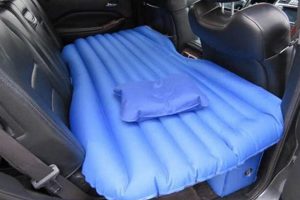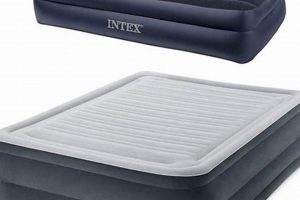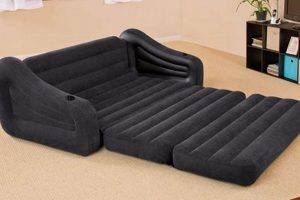A device utilized for inflating air mattresses, it employs a mechanism to draw in ambient air and forcefully inject it into the mattress’s sealed chambers. These devices range in complexity from simple manual bellows to electrically powered models. A common example involves preparing a guest bedroom; instead of laborious manual inflation, the device rapidly inflates an air mattress to a comfortable firmness.
The utility of these inflation mechanisms stems from their ability to provide a quickly deployable and portable sleeping surface. This functionality is particularly valuable in situations such as camping, accommodating overnight guests, or providing temporary bedding during relocation or emergency situations. Historically, such mechanisms have evolved from basic foot pumps to sophisticated units with features like automatic shut-off and deflation capabilities, reflecting advancements in portable comfort solutions.
The following sections will explore different types of such inflation systems, examine their operational principles, outline key features to consider when selecting a suitable model, and provide practical tips for effective usage and maintenance. Furthermore, the article will also delve into troubleshooting common problems and offer insights into extending the lifespan of both the device and the air mattress itself.
Effective Usage and Maintenance Tips
The efficient operation and extended lifespan of inflation devices for air mattresses are contingent upon adhering to certain practices and preventative measures.
Tip 1: Select the Appropriate Nozzle. Ensure the nozzle attachment is securely fitted to the air mattress valve. An improper fit can lead to air leakage and inefficient inflation.
Tip 2: Avoid Over-Inflation. Over-inflating an air mattress can compromise its structural integrity. Refer to the mattress’s specifications for recommended inflation levels and cease inflation once this level is reached.
Tip 3: Protect the Device During Storage. Store the device in a dry, clean environment, away from extreme temperatures and direct sunlight. This prevents degradation of the device’s components.
Tip 4: Regularly Inspect Power Cords and Hoses. Before each use, examine the power cord or hose for any signs of damage, such as cracks or fraying. Damaged components should be repaired or replaced immediately to prevent electrical hazards or performance issues.
Tip 5: Clean Air Filters (If Applicable). Certain models are equipped with air filters. Regularly cleaning these filters ensures optimal airflow and prevents the motor from overheating. Consult the manufacturer’s instructions for cleaning procedures.
Tip 6: Allow for Cool-Down Periods. Continuous operation can cause the motor to overheat, potentially leading to premature failure. Allow for brief cool-down periods during extended inflation or deflation cycles.
Tip 7: Deflate Completely for Storage. When storing the air mattress, use the device to fully deflate it. This reduces stress on the mattress material and makes it easier to fold and store compactly.
Following these recommendations will promote the continued effectiveness of the air mattress inflation device and safeguard the users investment. This is critical to maximizing the device effectiveness.
The subsequent section will provide troubleshooting guidance for common issues encountered during operation.
1. Inflation Speed
The parameter of inflation speed is a primary determinant of the operational efficiency and user convenience when utilizing an air mattress inflation device. The rate at which an air mattress can be inflated directly impacts the setup time and overall suitability for various applications.
- Airflow Rate
Airflow rate, typically measured in cubic feet per minute (CFM) or liters per minute (LPM), quantifies the volume of air the device can deliver over a given time period. A higher airflow rate translates to faster inflation times. For example, a device with a CFM of 10 will inflate a standard queen-size air mattress significantly quicker than a device with a CFM of 5. The implications extend to situations where rapid deployment of a sleeping surface is critical, such as accommodating unexpected guests or setting up camp in inclement weather.
- Motor Power
The power of the motor driving the inflation device is intrinsically linked to its inflation speed. A more powerful motor can generate greater pressure and sustain a higher airflow rate, resulting in faster inflation. Manual or foot-operated mechanisms rely on human exertion, which limits the achievable pressure and airflow. Electric devices, in contrast, can employ motors of varying power levels to optimize inflation speed. The practical consequence is that a robust motor allows for faster and more consistent inflation across various air mattress sizes and firmness settings.
- Nozzle Design and Seal
The design of the nozzle and its ability to create a tight seal with the air mattress valve influence the efficiency of the inflation process. A poorly designed nozzle or a compromised seal can lead to air leakage, reducing the effective airflow rate and prolonging inflation time. Conversely, a well-designed nozzle that creates a secure, airtight connection maximizes the transfer of air into the mattress, thereby enhancing inflation speed. This factor highlights the importance of nozzle compatibility and material quality in achieving optimal performance.
- Mattress Volume and Initial Pressure
The volume of the air mattress and its initial pressure directly affect the inflation time. Larger mattresses require a greater volume of air to reach the desired firmness, naturally increasing inflation duration. Similarly, if the mattress has lost a significant amount of air, the device will need to work harder and longer to achieve the target pressure. These factors underscore the correlation between mattress size and condition, and the performance expectations of the inflation device. Pre-inflation techniques, such as partially inflating the mattress manually, can mitigate this effect.
The interplay of airflow rate, motor power, nozzle design, and mattress volume defines the overall inflation speed achieved when using an air mattress inflation device. By understanding these factors, users can select a device that aligns with their specific needs and optimize the inflation process for efficient and convenient use.
2. Power Source
The operational capability of an air mattress inflation device is fundamentally determined by its power source. The energy input mechanism dictates not only the portability and convenience of the device but also its potential inflation speed and suitability for various environments. The absence of a compatible power source renders the inflation dev
ice inoperable, highlighting the direct cause-and-effect relationship.
Several power source options exist, each with distinct implications. Manual devices, such as foot pumps or bellows, rely on human physical exertion, offering independence from electrical outlets but limiting inflation speed and requiring considerable effort. Electric devices, conversely, utilize either alternating current (AC) from wall outlets or direct current (DC) from batteries or car adapters. AC-powered units offer consistent power for rapid inflation but necessitate proximity to a power outlet, restricting portability. DC-powered units enhance portability, particularly battery-operated versions, but battery life becomes a limiting factor, necessitating careful power management or availability of replacement batteries. Car adapter-powered units provide a compromise, leveraging the vehicle’s electrical system for inflation during travel. The choice of power source is therefore a critical design element influencing the device’s intended use case.
Selecting an appropriate power source for an air mattress inflation device depends on the specific context of its use. For home use, an AC-powered device offers reliable and rapid inflation. For camping or travel, a battery-operated or car adapter-powered device provides essential portability. Manual devices serve as a backup option in situations where electrical power is unavailable, albeit at the cost of increased physical effort. Understanding the interplay between power source, portability, inflation speed, and user effort is crucial for selecting an inflation device that effectively meets the user’s needs.
3. Portability
The characteristic of portability is a key factor influencing the utility and versatility of air mattress inflation devices. Portability directly affects the device’s suitability for applications beyond stationary home use, broadening its appeal to scenarios such as camping, travel, and emergency preparedness. A device lacking in portability inherently restricts its applicability to environments where a readily available power source and minimal space constraints exist.
The correlation between device size, weight, and power source contributes to its overall portability. Compact, lightweight devices with battery-powered or manual operation modes inherently offer greater portability compared to larger, heavier, AC-powered units. The practical significance of this distinction is evident in scenarios where space is limited, such as within a tent or a car trunk. Furthermore, the availability of integrated storage compartments for cords and nozzles enhances portability by streamlining the packing and unpacking process. Consider, for example, a family embarking on a camping trip; a compact, battery-operated inflation device allows for easy inflation of air mattresses at the campsite without the need for external power or cumbersome equipment.
In summation, portability is not merely a desirable feature but a functional requirement for maximizing the usability of air mattress inflation devices across diverse contexts. The interplay of size, weight, power source, and storage design determines the degree to which the device can be readily transported and deployed in varied environments. Prioritizing portability ensures that the inflation device serves as a versatile and adaptable solution for inflation needs, regardless of location. The subsequent aspect to be examined involves nozzle compatibility, further enhancing the practical utility.
4. Nozzle Compatibility
The effectiveness of a mattress air pump is contingent upon nozzle compatibility, a critical interface between the device and the inflatable mattress. A mismatch between the pump’s nozzle and the mattress’s valve directly impedes inflation, regardless of the pump’s power or airflow capacity. This incompatibility arises from variations in valve designs across different mattress brands and models, each requiring a specific nozzle shape and size for a secure, airtight seal. The practical consequence is that a pump with inadequate nozzle options becomes functionally useless for certain mattresses. For instance, attempting to inflate a mattress with a Boston valve using a standard pinch valve nozzle will inevitably result in air leakage and incomplete inflation, rendering the pump ineffective. The provision of multiple, interchangeable nozzles is therefore a fundamental design consideration for any versatile mattress air pump.
The impact of nozzle compatibility extends beyond mere inflation; it also affects the efficiency of deflation processes. Air mattresses are often deflated using the same valve through which they are inflated. If a mattress air pump lacks a nozzle suitable for creating a tight seal during deflation, the process becomes significantly slower and less effective. Users may resort to manually compressing the mattress, which is less efficient and potentially damaging. In contrast, a pump equipped with appropriate deflation nozzles facilitates rapid and complete air removal, simplifying mattress storage and reducing the risk of material stress. As an illustration, consider a user attempting to quickly deflate an air mattress after a camping trip; a pump with a compatible deflation nozzle streamlines the process, enabling prompt packing and minimizing disruption.
In conclusion, nozzle compatibility is not a peripheral feature but a core functional requirement of a mattress air pump. The ability to establish a secure, airtight connection with various mattress valve types is essential for both efficient inflation and deflation. Pumps lacking in nozzle versatility compromise their utility and diminish the overall user experience. Prioritizing nozzle compatibility ensures that the mattress air pump functions effectively across a range of applications, reinforcing its value as a practical and adaptable tool. This functionality improves the device’s general efficiency.
5. Deflation Capability
Deflation capability, as a function of a mattress air pump, significantly impacts the overall utility and practicality of both the device and the inflatable mattress itself. Its presence or absence dictates the ease and speed with which an air mattress can be prepared for storage, influencing convenience and long-term mattress integrity.
- Vacuum Suction Efficiency
The effectiveness of a pump’s deflation mechanism is directly correlated with its ability to create a vacuum and extract air from the mattress. Higher suction power allows for more complete air removal, resulting in a more compact and manageable mattress for storage. Examples include pumps equipped with dual-stage systems, which first expel the majority of the air and then switch to a high-vacuum mode to remove residual air. Insufficient suction can lead to bulky, partially deflated mattresses, hindering storage and increasing the risk of damage during handling.
- Valve Compatibility and Seal
Similar to inflation, successful deflation relies on a secure and airtight connection between the pump’s nozzle and the mattress valve. Incompatible nozzles or poorly designed seals can lead to air leakage, slowing down the deflation process and reducing its effectiveness. Mattress air pumps with a variety of nozzle at
tachments or universal adapters address this issue by ensuring compatibility with a wide range of valve types. The practical implications are that a properly sealed connection facilitates rapid and complete deflation, minimizing effort and maximizing storage efficiency. - Reverse Airflow Mechanism
The core of the deflation process lies in the pump’s ability to reverse the airflow direction. This mechanism allows the pump to draw air out of the mattress rather than forcing it in. Simple manual pumps often rely on reversing the action of the bellows, while electric pumps employ internal valves or motor direction switches. The efficiency of this reverse airflow mechanism determines the speed and effectiveness of deflation. A poorly designed reverse airflow system can result in slow or incomplete deflation, negating the convenience benefits of a powered pump.
- Automated Deflation Settings
Some advanced mattress air pumps incorporate automated deflation settings that simplify the process. These settings typically involve pre-programmed cycles that run until a pre-determined pressure level is reached, at which point the pump automatically shuts off. Automated deflation settings eliminate the need for constant monitoring and reduce the risk of over-deflation, which can damage the mattress. The implementation of automated deflation settings increases user convenience and contributes to the long-term preservation of the air mattress.
These factors collectively underscore the importance of deflation capability as an integral function of a mattress air pump. The ability to efficiently and effectively deflate an air mattress is essential for convenient storage, long-term mattress preservation, and overall user satisfaction. Pumps lacking in robust deflation capabilities compromise their versatility and diminish the user experience, highlighting the need for a balanced approach to both inflation and deflation functionalities.
Frequently Asked Questions About Mattress Air Pumps
This section addresses common inquiries regarding mattress air pumps, providing factual and objective information to enhance understanding of these devices.
Question 1: What is the typical lifespan of a mattress air pump?
The operational lifespan of a mattress air pump varies depending on usage frequency, storage conditions, and build quality. Generally, a well-maintained electric pump can last between 3 to 5 years, while manual pumps, with fewer mechanical components, may endure longer with proper care.
Question 2: Can a mattress air pump be used for inflating items other than air mattresses?
While primarily designed for air mattresses, certain mattress air pumps, particularly those with multiple nozzle attachments, can be adapted for inflating other inflatable items such as pool toys, inflatable boats, or sports equipment. However, users should verify compatibility and pressure limits to avoid damage.
Question 3: What is the optimal pressure for inflating an air mattress using a mattress air pump?
The recommended pressure for an air mattress is typically indicated on the mattress itself. Over-inflation can lead to seam damage and reduced lifespan, while under-inflation results in a less comfortable sleeping surface. Using the pump to achieve the recommended firmness, verified by touch, is advisable.
Question 4: What are the common causes of mattress air pump failure?
The common causes for failure often include overheating due to prolonged use, damage to the power cord, obstructions in the air intake, or wear and tear on internal components. Regular inspection and proper storage can mitigate these risks.
Question 5: Are there specific maintenance requirements for mattress air pumps?
Yes, maintenance includes regularly cleaning air filters (if applicable), inspecting the power cord for damage, ensuring proper nozzle fit, and storing the pump in a dry, clean environment. Following the manufacturer’s recommendations is essential for optimal performance.
Question 6: What safety precautions should be observed when using a mattress air pump?
Safety precautions include ensuring the power source is compatible, avoiding use in wet or damp environments, preventing obstructions of air intakes, and refraining from operating the pump for extended periods to prevent overheating. Furthermore, users should never leave a pump unattended during operation.
Proper maintenance and adherence to usage guidelines contribute to the longevity and safe operation of a mattress air pump. Understanding these factors is essential for maximizing the device’s utility.
The subsequent section provides a summary of the key considerations for purchasing a mattress air pump.
Mattress Air Pump
This exploration has clarified the multifaceted nature of the term “mattress air pump,” dissecting its functional characteristics, power source dependencies, portability considerations, nozzle compatibility imperatives, and deflation capabilities. Understanding these elements is crucial for making informed purchasing decisions and ensuring proper device utilization. Failure to consider these factors can lead to inefficient operation, reduced lifespan, or even complete device failure.
The informed selection and responsible use of a mattress air pump represent a commitment to convenience, efficiency, and long-term equipment care. Neglecting the outlined considerations can result in compromised performance and premature replacement needs. Therefore, careful assessment and diligent maintenance are paramount for maximizing the value and longevity of any chosen model. With careful consideration to previously stated insights, it’s possible to achieve efficient operation.







